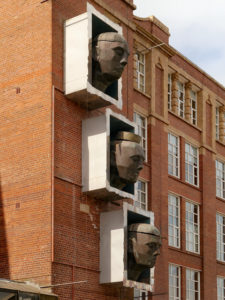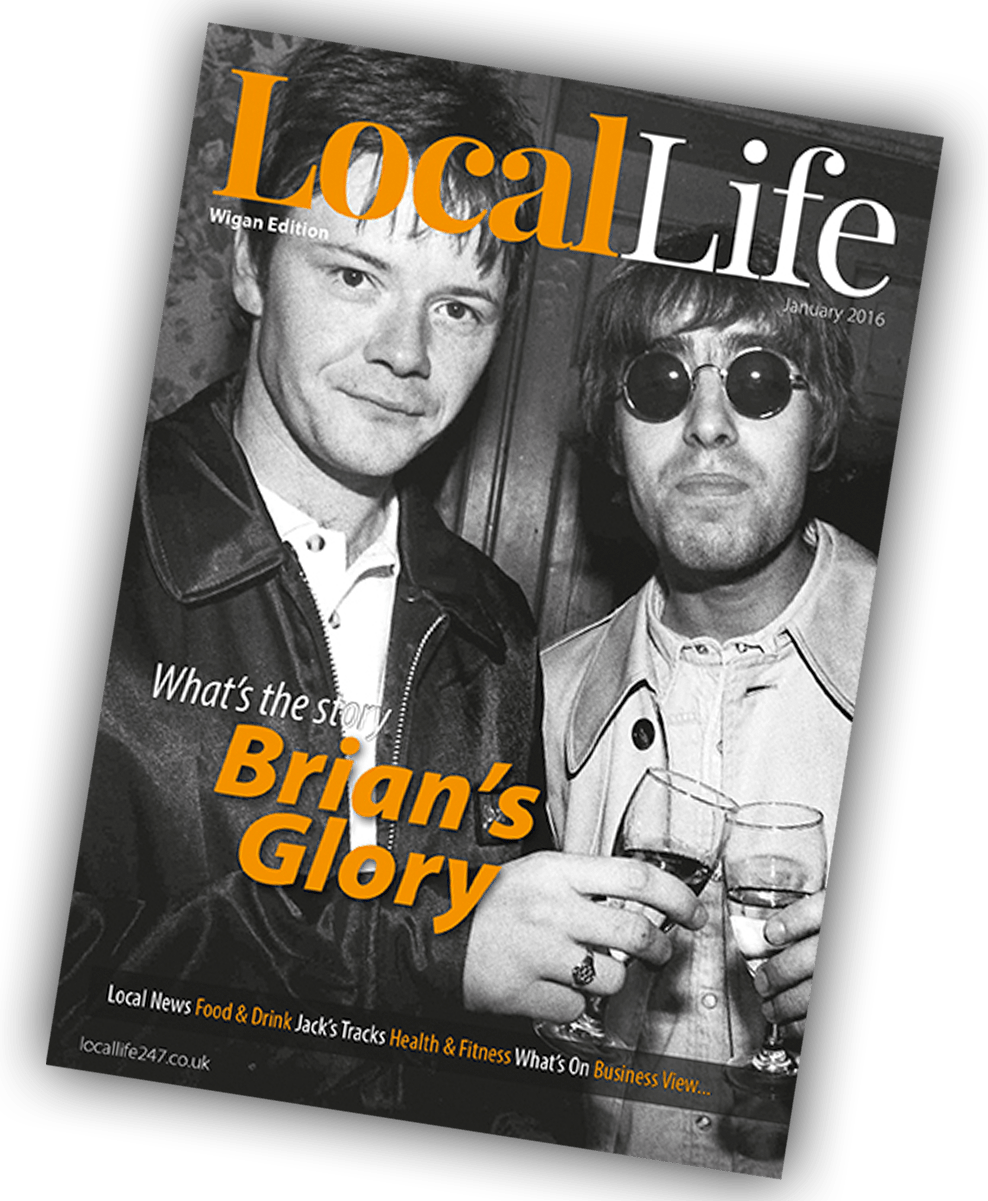Warp & Weft
Sculpted by Adrian Moakes, Wigan Warp and Weft was erected in 2002, and is said to represent the relationship between the town’s former major industries. Aptly named after a weaving technique to turn yarn into fabric, the sweeping structure’s individual parts intertwine with one another as they sprout upwards as Wigan’s future grows beyond mills and mining. Is it coincidence that the crossed points make a W?
Face of Wigan
Towering 18 feet above The Wiend in Wigan town centre, the Face of Wigan was created by sculptor Rick Kirby in 2008. It was originally located in the Grand Arcade and cost £80,000, which was funded by Modus Properties.
Rather than capturing a famous Wigan face, the giant bust is sculpted from hundreds of reflective panels to create a huge mirror image of Wigan residents. They are, after all, the true ‘face’ of the town. Kirby himself commented at the time of the sculpture’s construction that ‘these are the people who make the place what it is today, and indeed have the power to determine what will be the future.’
Douglas Dragonflies
These bronze dragonflies can be found along the River Douglas just off Hilton Street. The Douglas and Yarrow Valley Action group and Tesco commissioned artist Joanne Risley to create the swooping insects, which rest at the top of branch-like poles three metres high.
Giant Rugby Ball
Another of Joanne Risley’s works, Tesco shoppers are all well aware of the giant rugby ball which harks back to the town’s legendary sporting career. Erected in 2001, the sculpture depicts a traditional ball complete with laces and embossed rugby players to commemorate the former Central Park stadium which lay on the site. Central Park dates back to 1902; the stadium saw its last ever game played in September 1999, with Wigan beating St. Helens.
Billy Boston
Wiganers might not have been able to choose from the ream of famous rugby faces when they opted for the giant rugby ball, but one man stands out from the crowd. Billy Boston made his debut at Central Park in 1953 for Wigan and went on to play 31 games for Great Britain. He was the first non-white player to tour Australia and New Zealand in 1954, and scored a record number of tries in the process.
His likeness – holding a rugby ball and clad in Boston’s iconic kit – stands in Believe Square and was crafted by sculptor Steve Winterburn. It was unveiled in 2016, with Boston in attendance.
Sir Francis Powell
For decades it’s been considered good luck to rub the foot of Sir Francis Sharpe Powell in Mesnes Park. It’s believed the tradition began after the war, when children were drawn to the statue for luck when it would have been in high demand.
Powell, the 1st Baronet, was born in Wigan in 1827, and became Conservative MP for the town from 1863-1910. His statue was designed by Ernest Gillick and erected in 1910.
George Formby
Ask anyone which musician they associate with Wigan, and they’ll probably opt for George Formby. Born George Hoy Booth, the keen ukulele player was born in the town in 1904, and delighted a worldwide audience with comical songs and films throughout the 1930s and 40s. Members of the George Formby Society helped bring the statue, which stands inside the Grand Arcade, brandishing his famous ukulele, to life in 2007. Indeed, George looks as though he might be about to break into a rendition of When I’m Cleaning Windows.
Dave Whelan
Outside the DW Stadium rests a bronze monument to Wigan Athletic’s Dave Whelan, owner of the club from 1995-2018. Unveiled in 2016, Whelan is pictured holding the FA Cup which his Wigan team won in 2013 following a match against Manchester City – their first major trophy in their Premier League history.
Automata
Along the chimney breast of Trencherfield Mill lie three curious mechanical faces. Designed by Andy Hazell in 1999, the faces are said to represent a family, and originally moved continuously as though coming to life. The top of a head opened and closed, the middle spun around, while the bottom face had a tin opener rotating around its head.

People of the Pier
Wigan Pier was originally supposed to have four statues, but each has a sad history of vandalism. In 2009, before they were due to be unveiled to the artist, two of the statues were stolen. The first, depicting a Pit Brow Lass working on the canal was eventually found underwater and rescued, now standing along the canal a little way down from the entrance. The second statue, of a boat builder, was never found. You can also spot a bargee looking over the water close to the entrance, though his flatcap has been sheared from his head, and the mill worker, sitting on a bench by Trencherfield Mill, was decapitated.
Spirit of Wigan
Located on the Landgate roundabout in Marus Bridge, the Spirit of Wigan is a tall metal arch with three figures poised to perform acrobatics along it. The sculpture was unveiled back in 2006 and reaches 10 metres into the air – it was created by local artist Clare Bigger to represent Wigan’s strength and optimism in the face of adversity. The figures at the bottom of the sculpture symbolise labourers from the cotton and coal industries – which were vital in establishing Wigan as a major player up North – while the future figure rises above them.
Little Jimmy White
On the site of the first Methodist church in Lamberhead Green – Wesleyan Methodist Church, built in 1790 – sits ‘Little Jimmy White’s Garden’. When Pemberton’s new church was built the old one was demolished, and all those resting in the small cemetery were relocated to St. John’s Churchyard.
In 2003, the Pemberton Community Association decided to renovate the neglected site, designing a memorial garden to the former chapel and churchyard. Watching over the garden is a wooden statue of a WWI soldier, and a regular memorial service now takes place in November each year.
Boer War Memorial
In 2013, a new Boer War Memorial was erected in Mesnes Park to commemorate the Wigan soldiers who lost their lives. The original statue, which depicted a British soldier standing victoriously during the Second South Africa War (1899-1902), was removed in 1968 after suffering from pollution and vandalism – rumours say it is buried somewhere within the park. The new statue can be found outside Frederick’s Ice Cream Parlour.
Going Green
A new topiary sculpture was commissioned as part of The Deal in 2016. A huge green mother and son hold brooms to clean up the environment on Northway, opposite Wigan Market. This huge piece of eco-art encourages the local community to get involved in cleaning up their act too.
Notable Mentions
- Hands of Ince, Walmesley Park
- Scholes Sign, Scholes
- Red Wood Sculptures, Redwood Park, Orrell
- Memorial Cenotaph, Wigan Parish Church


